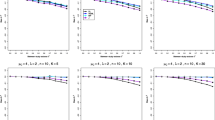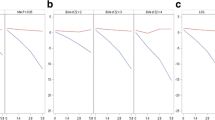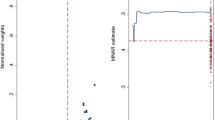Abstract
The application of proportional odds models to ordered categorical data using the mixed-effects modeling approach has become more frequently reported within the pharmacokinetic/pharmacodynamic area during the last decade. The aim of this paper was to investigate the bias in parameter estimates, when models for ordered categorical data were estimated using methods employing different approximations of the likelihood integral; the Laplacian approximation in NONMEM (without and with the centering option) and NLMIXED, and the Gaussian quadrature approximations in NLMIXED. In particular, we have focused on situations with non-even distributions of the response categories and the impact of interpatient variability. This is a Monte Carlo simulation study where original data sets were derived from a known model and fixed study design. The simulated response was a four-category variable on the ordinal scale with categories 0, 1, 2 and 3. The model used for simulation was fitted to each data set for assessment of bias. Also, simulations of new data based on estimated population parameters were performed to evaluate the usefulness of the estimated model. For the conditions tested, Gaussian quadrature performed without appreciable bias in parameter estimates. However, markedly biased parameter estimates were obtained using the Laplacian estimation method without the centering option, in particular when distributions of observations between response categories were skewed and when the interpatient variability was moderate to large. Simulations under the model could not mimic the original data when bias was present, but resulted in overestimation of rare events. The bias was considerably reduced when the centering option in NONMEM was used. The cause for the biased estimates appears to be related to the conditioning on uninformative and uncertain empirical Bayes estimate of interindividual random effects during the estimation, in conjunction with the normality assumption.
Similar content being viewed by others
REFERENCES
A. Agresti. Modelling ordered categorical data: recent advances and future challenges. Stat. Med. 18: 2191–2207 (1999).
R. Stiratelli, N. Laird, and J. H. Ware. Random-effects models for serial observations with binary response. Biometrics 40: 961–971 (1984).
D. A. Harville, and R. W. Mee. A mixed-model procedure for analysing ordered categor-ical data. Biometrics 40: 393–408 (1984).
L. B. Sheiner. A new approach to the analysis of analgesic drug trials, illustrated with bromfenac data. Clin. Pharmacol. Ther. 56: 309–322 (1994).
F. Ezzet, and J. Whitehead. A random effects model for ordinal responses from a cross-over trial. Stat Med. 10: 901–6;discussion 906-7 (1991).
C. A. Knibbe, K. P. Zuideveld, J. Dejongh, P. F. Kuks, L. P. Aarts, and M. Danhof. Population pharmacokinetic and pharmacodynamic modeling of propofol for long-term sedation in critically ill patients: a comparison between propofol 6%and propofol 1%. Clin. Pharmacol. Ther. 72: 670–684 (2002).
S. K. Gupta, G. Sathyan, E. A. Lindemulder, P. L. Ho, L. B. Sheiner, and L. Aarons. Quantitative characterization of therapeutic index: application of mixed-effects modeling to evaluate oxybutynin dose-efficacy and dose-side effect relationships. Clin. Pharmacol. Ther. 65: 672–684 (1999).
X. Lin and N. E. Breslow. Bias correction in generalized linear mixed models with multi-ple components of dispersion. J. Am. Stat. Assoc. 91: 1007–1016 (1996).
G. Rodriguez and N. Goldman. An assessment of estimation procedures for multilevel models with binary responses. J R Stat. Soc A. 158: 73–89 (1995).
N. H. Holford, H. C. Kimko, J. P. Monteleone, and C. C. Peck. Simulation of clinical trials. Annu. Rev. Pharmacol. Toxicol. 40: 209–234 (2000).
S. Chabaud, P. Girard, P. Nony, and J. P. Boissel. Clinical trial simulation using thera-peutic effect modeling: application to ivabradine efficacy in patients with angina pectoris. J. Pharmacokinet. Pharmacodyn. 29: 339–363 (2002).
S. L. Beal and L. B. Sheiner NONMEM Users Guides. Hanover, Maryland: GloboMax, Inc., 1989-1998.
D. J. Lunn, J. Wake eld, and A. Racine Poon. Cumulative logit models for ordinal data: A case study involving allergic rhinitis severity scores. Stat. Med. 20: 2261–2285 (2001).
D. R. Mould, N. H. Holford, J. H. Schellens, J. H. Beijnen, P. R. Hutson, H. Rosing, W. W. tenBokkel Huinink, E. K. Rowinsky, J. H. Schiller, M. Russo, and G. Ross. Pop-ulation pharmacokinetic and adverse event analysis of topotecan in patients with solid tumors. Clin. Pharmacol. Ther. 71: 334–348 (2002).
L. Aarons and G. Graham. Methodological approaches to the population analysis of toxicity data. Toxicol. Lett. 120: 405–410 (2001).
I. Nestorov, G. Graham, S. Duffull, L. Aarons, E. Fuseau, and P. Coates. Modeling and simulation for clinical trial design involving a categorical response: a phase II case study with naratriptan. Pharm. Res. 18: 1210–1219 (2001).
J. W. Mandema and D. R. Stanski. Population pharmacodynamic model for ketorolac analgesia. Clin. Pharmacol. Ther. 60: 619–635 (1996).
S. L. Beal, and L. B. Sheiner NONMEM Users Guide-Part VII: Conditional Estimation Methods. GloboMax, Inc., Hanover, Maryland, 1992-1998.
J. C. Pinheiro and D. M. Bates. Approximations to the log-likelihood function in the nonlinear mixed-effects model. J. Comput. Graph. Stat. 4: 12–35 (1995).
SAS Institute Inc SAS Online Doc, SAS/STAT User 's Guide, The NLMIXED Proce-dure. http: //statdist. its. uu. se/sas/SASOnlinedocV8/sasdoc/saspdf/.
J. Wake eld and S. Walker. A population approach to initial dose selection. Stat. Med. 16: 1135–1149 (1997).
M. O. Karlsson, E. N. Jonsson, C. G. Wiltse, and J. R. Wade. Assumption testing in population pharmacokinetic models: illustrated with an analysis of moxonidine data from congestive heart failure patients. J. Pharmacokinet. Biopharm. 26: 207–246 (1998).
M. C. Kjellsson, S. Jönsson, and M. O. Karlsson The Back-Step Method-Method for Obtaining Unbiased Population Parameter Estimates for Ordered Categorical Data, AAPS J. 6: article 19, (2004).
S. Jonsson and M. O. Karlsson. Estimating bias in parameters for some NONMEM models for ordered categorical data. http: //www. page-meeting. org/(2002).
K. G. Kowalski, L. McFadyen, M. M. Hutmacher, B. Frame, and R. Miller. A two-part mixture model for longitudinal adverse event severity data. J. Pharmacokinet. Pharmaco-dyn. 30: 315–336 (2003).
Author information
Authors and Affiliations
Rights and permissions
About this article
Cite this article
Jönsson, S., Kjellsson, M.C. & Karlsson, M.O. Estimating Bias in Population Parameters for Some Models for Repeated Measures Ordinal Data Using NONMEM and NLMIXED. J Pharmacokinet Pharmacodyn 31, 299–320 (2004). https://doi.org/10.1023/B:JOPA.0000042738.06821.61
Issue Date:
DOI: https://doi.org/10.1023/B:JOPA.0000042738.06821.61




